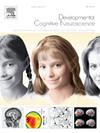青春期女孩心智化和换位思考倾向的纵向神经影像学研究
IF 4.6
2区 医学
Q1 NEUROSCIENCES
引用次数: 0
摘要
发展心理学的研究表明,自我概念的形成和心智化能力及其神经基础在青春期表现出显著的发展变化。换位思考的倾向也被认为在青春期会增加,支持亲社会行为的细化和日益复杂的社会关系的需求。为了探索这些过程在青春期的发展及其相互关系,青春期早期的女孩(N = 172)在大约相隔18个月(平均年龄分别为11.62岁和13.20岁)的两个波中完成了观点采取倾向的测量和自我评估功能磁共振成像任务。与我们的假设一致,换位思考倾向与年龄呈正相关。更强的换位思考倾向也与更亲社会、更少反社会的自我概念相关。此外,dmPFC的活动随着年龄的增长而增加,但这并没有在所有思维区域的多重比较中幸存下来。事后分析还表明,跨波换位思考倾向的增加与第二波楔前叶部分的活动显著相关。最后,虽然我们没有观察到交叉变量耦合,但我们的双变量潜在变化评分模型显示,波1中较低的观点采取倾向与该变量中较大的潜在变化相关(对于心智化大脑区域的平均活动也是如此)。本文章由计算机程序翻译,如有差异,请以英文原文为准。
A longitudinal neuroimaging study of adolescent girls’ mentalizing and perspective-taking tendencies
Research in developmental psychology suggests that self-concept formation and mentalizing capacities, along with their neural foundations, show significant developmental change during adolescence. Perspective-taking tendencies are also believed to increase in adolescence, supporting the refinement of prosocial behavior and the demands of increasingly complex social relationships. To explore the development of, and relationship between, these processes in adolescence, early adolescent girls (N = 172) completed a measure of perspective-taking tendencies and a self-evaluation fMRI task at two waves, approximately 18 months apart (mean ages = 11.62 and 13.20, respectively). In line with our hypothesis, perspective-taking tendencies were positively associated with age. Greater perspective-taking tendencies were also associated with a more prosocial, and less antisocial, self-concept. In addition, dmPFC activity increased with age, but this did not survive correction for multiple comparisons across all mentalizing regions. Post hoc analyses also showed that an increase in perspective-taking tendencies across waves was significantly associated with activity in parts of the precuneus at wave 2. Finally, while we did not observe cross-variable coupling, our Bivariate Latent Change Score model showed that lower perspective-taking tendencies at wave 1 were associated with greater latent change in this variable (and the same was true for mean activity in mentalizing brain regions).
求助全文
通过发布文献求助,成功后即可免费获取论文全文。
去求助
来源期刊

Developmental Cognitive Neuroscience
NEUROSCIENCES-
CiteScore
7.60
自引率
10.60%
发文量
124
审稿时长
6-12 weeks
期刊介绍:
The journal publishes theoretical and research papers on cognitive brain development, from infancy through childhood and adolescence and into adulthood. It covers neurocognitive development and neurocognitive processing in both typical and atypical development, including social and affective aspects. Appropriate methodologies for the journal include, but are not limited to, functional neuroimaging (fMRI and MEG), electrophysiology (EEG and ERP), NIRS and transcranial magnetic stimulation, as well as other basic neuroscience approaches using cellular and animal models that directly address cognitive brain development, patient studies, case studies, post-mortem studies and pharmacological studies.
 求助内容:
求助内容: 应助结果提醒方式:
应助结果提醒方式:


